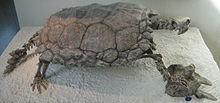Ankylopoda
| Ankylopoda | |
|---|---|

| |
| Proganochelys quenstedti | |
| Scientific classification | |
| Domain: | Eukaryota |
| Kingdom: | Animalia |
| Phylum: | Chordata |
| Class: | Reptilia |
| Clade: | Sauria |
| Clade: | Ankylopoda Lyson et al., 2012 |
| Extant subclades | |
Ankylopoda is a clade that contains turtles and lepidosaurs (Tuatara, lizards and snakes) and their fossil relatives. This clade is supported based on microRNAs[1] as well as the fossil record.[2] Stem-turtles and lepidosaurs have unique skull elements and features not seen in archosaurs (represented by extant crocodilians and birds).
Classification
The cladogram below follows the most likely result found by another analysis of turtle relationships, this one using only fossil evidence, published by Rainer Schoch and Hans-Dieter Sues in 2015. This study found Eunotosaurus to be an actual early stem-turtle, though other versions of the analysis found weak support for it as a parareptile.[3]
See also
Archelosauria, an alternative clade that places turtles as sister taxon to archosaurs.
References
- ^ Lyson, T.R.; Sperling, E.A.; Heimberg, A.M.; Gauthier, J.A.; King, B.L.; Peterson, K.J. (2012). "MicroRNAs support a turtle + lizard clade". Biol. Lett. 8 (1): 104–107. doi:10.1098/rsbl.2011.0477. PMC 3259949. PMID 21775315.
- ^ Schoch, R. R.; Sues, H.-D. (2015). "A Middle Triassic stem-turtle and the evolution of the turtle body plan". Nature. 523 (7562): 584–7. doi:10.1038/nature14472. PMID 26106865.
- ^ Schoch, Rainer R.; Sues, Hans-Dieter (24 June 2015). "A Middle Triassic stem-turtle and the evolution of the turtle body plan" (PDF). Nature. 523 (7562): 584–587. doi:10.1038/nature14472. PMID 26106865.
